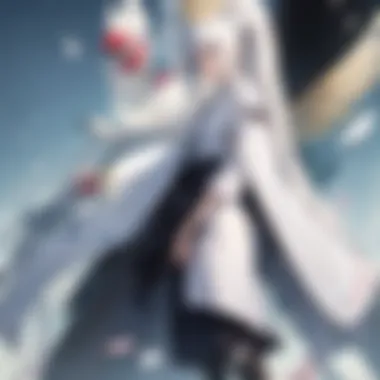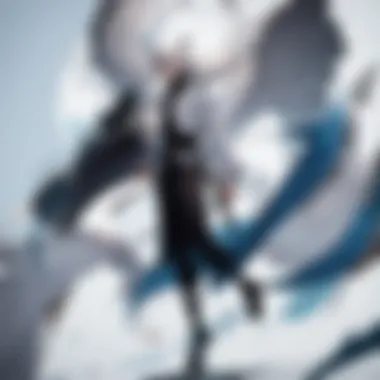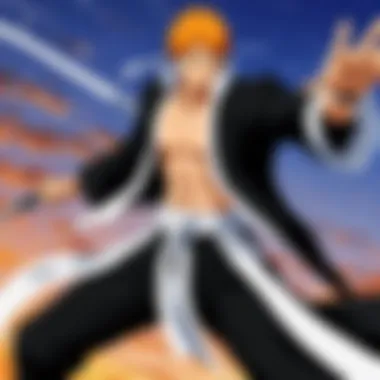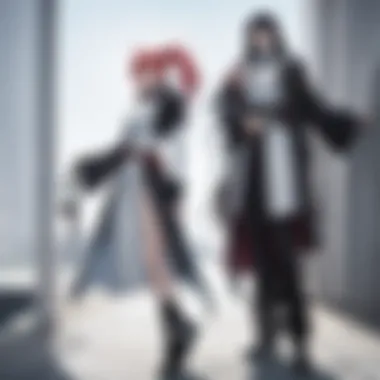A Comprehensive Overview of All Episodes of Bleach


Intro
Bleach stands as a landmark in anime history, resonating with viewers through its intricate narrative and rich character development. This article aims to unpack all episodes of Bleach, from its earliest beginnings to its climactic conclusions. We will delve into various aspects of the series, including episode reviews that encapsulate the essence of each story segment, character spotlights that expose individual arcs, and a thoughtful examination of the differences between the anime and manga formats. The analysis also covers industry updates relevant to the Bleach legacy, offering a holistic view of its impact and relevance in modern anime culture.
As we embark on this comprehensive journey, anime enthusiasts will find a detailed resource that endeavors to thoroughly assess the show, encouraging a deeper understanding of its themes and characters. Whether you are a long-time fan or a recent viewer, this guide combines critical insights with an appreciation for the artistry and storytelling at play within Bleach.
Prelude to Bleach
Bleach is a significant and complex work in the anime and manga landscape. Understanding its core elements serves as a foundation for appreciating the intricate narratives and character journeys presented throughout its run. This overview not only prepares the audience for specific story arcs but also provides perspective on the series’ evolution and cultural implications.
Overview of the Series
Bleach, created by Tite Kubo, initially debuted in 2001 as a manga and gained immense popularity, leading to its adaptation into an anime. The story revolves around Ichigo Kurosaki, a teenager who gains the abilities of a Soul Reaper. His primary mission is to protect the living world from evil spirits while guiding departed souls to the afterlife.
The series is marked by its unique world-building, blending elements of action, supernatural themes, and personal growth. The narrative is organized into several major arcs, each contributing to character development and plot progression. Ichigo's relationships with other characters also deepen the story, driving many of the conflicts and resolutions seen throughout the series.
Cultural Impact
Bleach has left a lasting cultural impact that resonates with a diverse audience. It shared the stage with other prominent shonen series, like Naruto and One Piece, during its peak, which helped in defining the anime boom of the 2000s. Its themes of friendship, sacrifice, and the consequences of one's actions speak to universal experiences, making it relatable for many fans.
Furthermore, Bleach has inspired a variety of merchandise, video games, and even live-action adaptations, contributing to the franchise's financial success and widespread recognition. The series has also sparked discussions among fans regarding its themes and character arcs, solidifying its place as an enduring topic in anime discourse.
"The rich narrative of Bleach encourages deep analysis and conversation among fans, highlighting its complexity beyond just entertainment."
In summary, the importance of the introduction to Bleach lies in its ability to connect with audiences, not only through entertainment but also through deep thematic exploration and cultural relevance. Understanding this background enriches the viewing experience and underscores the significance of the series as a whole.
The Creation of Bleach
The inception of Bleach is a critical landmark in the anime and manga world. Understanding the creation process illuminates how Tite Kubo's unique vision translated into a series that captivated millions. This section will explore Kubo's inspirations, the creative decisions he faced, and the hurdles encountered during the production. These elements help to appreciate the depth of the series and its influence on the genre distinctively.
Tite Kubo's Vision
Tite Kubo's conceptualization of Bleach was primarily fueled by his childhood experiences and interests in supernatural themes and urban settings. As a young artist, Kubo was driven by the desire to blend action with intricate storytelling. His initial idea centered around the Shinigami, spiritual beings responsible for guiding souls to the afterlife. This core concept reflects a clash of the living world and the spirit realm, creating a unique narrative framework.
Kubo’s art style is another distinguishable aspect. He combined simplistic character designs with elaborate combat sequences, establishing a visually engaging aesthetic. The integration of fashion also adds a modern twist. Characters often sport distinctive outfits, which hugely appealed to the youth culture in Japan and beyond.
Furthermore, Kubo deliberately designed characters that represent a variety of attributes. Each main character embodies different human experiences and emotions, allowing viewers to connect deeply. Ichigo's journey, for instance, reflects themes of identity and responsibility. Overall, Kubo's vision was ambitious, seeking not merely to entertain but to provoke thought about moral dilemmas faced by the characters.
Challenges during Production
The journey of producing Bleach was not devoid of significant challenges. From balancing story arcs to managing character development, Kubo faced a myriad of obstacles that shaped the series' direction.
One prominent issue was the pacing. As the manga gained popularity, there was immense pressure to keep up with the release schedule. Continuous story arcs, such as the Soul Society Arc, initially showcased gripping narratives but also led to the inclusion of filler episodes that deviated from the main storyline. This decision often divided the fanbase, with some feeling that the fillers diluted the quality of the series.
In addition, competitor titles emerged as new contenders. Series like Naruto and One Piece were gaining traction, which forced Kubo to innovate continually. The demands of maintaining relevance in a highly competitive environment led to intense creative strain.
Moreover, there were personal challenges for Kubo. As the series progressed, he faced health issues that affected his productivity. Reflecting on this, Kubo took breaks, allowing him some recovery time while ensuring the narrative remained coherent when he returned.
Bleach: The Narrative Structure
The narrative structure of Bleach is essential for understanding its vast world and character motivations. Unpacking this structure provides insights into the series' thematic depth. The story unfolds across multiple seasons, each crafted with distinct arcs that shape the overall progression. This structure is important as it allows viewers to grasp how plot elements intertwine, and character development breathes life into the storyline. Moreover, analyzing this narrative framework highlights the series' ability to engage viewers on different levels, from casual watchers to die-hard fans.
Overview of Seasons


Bleach is divided into several seasons, each representing different phases of plot advancement. The first season introduces Ichigo Kurosaki and establishes the central premise—his transition from a high school student to a Soul Reaper. As the series progresses, each subsequent season expands on the world of Soul Society, the different realms, and the intricate relationships among characters.
The following is a brief overview of the seasons:
- Season One: Focuses on Ichigo’s introduction to the Soul Reapers and the battles against Hollows.
- Season Two: Delves into the Soul Society, introducing key characters and setting up significant conflicts.
- Season Three: Centers around the Bounts, adding new dimensions to the power dynamics.
- Season Four: Introduces the Arrancar, presenting complex villains with unique motivations.
- Season Five: Shifts to Hueco Mundo, where major battles take place.
- Season Six: Features the Fake Karakura Town, highlighting battles involving the Soul Reapers against formidable foes.
- Season Seven: Concludes the series with the Thousand-Year Blood War, a culmination of all prior conflicts.
Each season reinforces the main themes and character arcs, offering viewers different experiences while providing continuity of character and story development.
Key Arcs and Their Importance
In Bleach, story arcs serve as pivotal points for character evolution and thematic exposition. The importance of these arcs lies in how they contribute to the narrative and deepen the viewer's connection to the characters and their struggles.
Some key arcs include:
- The Substitute Shinigami Arc: Sets the foundation for the series, establishing Ichigo’s role and familiarizing viewers with the Soul Reapers. This arc is crucial for character introduction and setting up essential conflicts.
- The Soul Society Arc: This arc serves as a journey into the heart of the Soul Society, introducing complex dynamics and revealing character backstories. It is here that the stakes become higher, and Ichigo’s motivations are fully realized.
- The Arrancar Arc: This arc plays an important role in expanding the universe. With the introduction of new villains, viewers see how the Shinigami must adapt to new threats and alliances.
The arcs not only develop the characters but also engage with broader themes, such as friendship, sacrifice, and the eternal fight between good and evil. They invite viewers to reflect on their personal journeys, paralleling Ichigo’s with their own, reinforcing the emotional backbone of the series.
“The stories within Bleach are layered, with each arc adding depth not only to the plot but also to character psyche.”
By dissecting the arcs, readers can appreciate the complexity of Bleach's world. Each arc is not just a plot device but a vital part of a larger narrative mosaic that captivates its audience.
Season by Season Analysis
The analysis of each season in Bleach provides a critical understanding of its narrative evolution. This section emphasizes significant plot points, character development, and thematic elements present in every season, allowing readers to appreciate the intricacies of the series. By dissecting the arcs within the context of the bigger picture, fans can gain insights into character motivations and overarching storylines, making this analysis a valuable resource. In this way, readers can also follow the progression of key themes, such as the nature of sacrifice, friendship, and personal growth.
Season One: The Substitute Shinigami Arc
The first season sets the stage for Ichigo Kurosaki's unexpected journey into the world of Soul Reapers. This arc introduces Ichigo's struggles as he grapples with his new role after gaining Shinigami powers from Rukia Kuchiki. The foundational elements, such as the concept of souls and the duties of a Soul Reaper, are clearly defined.
Several core characters are introduced, establishing their relationships and conflicts. The rivalry with characters like Uryu Ishida and the friendship with Orihime Inoue are pivotal. These interactions enhance character depth and build a solid base for future developments. The overarching theme of accepting one's responsibilities becomes evident as Ichigo battles Hollows and tries to understand his new reality.
Season Two: The Soul Society Arc
This season marks a significant turning point in the series, escalating the stakes for Ichigo. After Rukia is captured, Ichigo and his allies embark on a rescue mission into the Soul Society, introducing viewers to the complex hierarchy and politics of Soul Reapers.
Key battles unfold as Ichigo encounters high-ranking Soul Reapers, most notably Byakuya Kuchiki. The introduction of the Soul Society’s formidable protectors not only serves to challenge Ichigo but also highlights his growth and determination. This arc emphasizes themes of loyalty and the bonds of friendship, as each character faces their struggles for the greater good.
Season Three: The Bount Arc
Deviating from the main plot, this season introduces the Bounts, who seek revenge on the Soul Society. While some viewers may criticize this arc for its lack of direct connection to the overarching narrative, it nonetheless explores deeper character motivations.
Ichigo must face not only external threats but also confront shadows from his past. The significance of this arc lies in its exploration of themes like redemption and the consequences of one's actions. The Bounts are multidimensional, displaying traits that make them relatable, further enriching the series.
Season Four: The Arrancar Arc
The Arrancar arc enhances the existing conflict, introducing Espada members as new antagonists. These characters are not just villains; they each possess their unique motivations and backstories, which adds complexity.
As Ichigo faces stronger opponents, the stakes rise significantly. The season also explores moral ambiguity through characters like Grimmjow Jaegerjaquez, showcasing the blurred lines between good and evil. The focus on Ichigo's evolving powers and abilities sets the pace for further character development leading to the climax.
Season Five: The Hueco Mundo Arc
This arc showcases the transition from battles in the Soul Society to the realm of Hueco Mundo. Ichigo and his friends must navigate new environments filled with traps and dark pressures. Here, viewers witness the camaraderie and strategic teamwork among Ichigo and his allies.


The narrative dives into the backstories of the Arrancar, particularly focusing on their pasts with the Soul Society. These revelations highlight the vast world the series has created, reinforcing themes of longing and loss. This arc emphasizes personal growth as characters integrate their past into their current motives.
Season Six: The Fake Karakura Town Arc
As battles shift to the insidious Fake Karakura Town, the intensity of confrontations increases. With the clash against Aizen, the stakes have never been higher. Aizen's complex nature as a villain is unveiled further, offering intellectual depth to his character.
The theme of betrayal comes to the forefront as trust becomes a scarce resource among characters. Relationships are tested in high-stakes situations, underscoring the idea that loyalty can be fleeting in times of crisis. The arc effectively delivers suspense while expanding on critical character dynamics.
Season Seven: The Thousand-Year Blood War Arc
This final arc marks the conclusion of the overarching narrative, delving into the long-standing conflict between Soul Society and Quincy. The stakes reach unprecedented heights, and the gathering of characters from past seasons builds to an incredible crescendo.
This arc brings closure to various storylines while exploring the weight of legacy and the complexities of revitalizing old rivalries. Themes of sacrifice and loss are interwoven, capturing the essence of what it means to protect loved ones even at great costs. The final battles are both emotional and action-packed, culminating in a powerful resolution to Ichigo’s journey.
This breakdown of each season underscores the intricate storytelling of Bleach and its capacity to convey profound themes through character arcs.
Character Analysis
Character analysis plays a crucial role in understanding the depth and intricacies of Bleach. Each character, from protagonists to antagonists, is carefully crafted with unique traits, motivations, and developments. Analyzing these characters illuminates their interactions and the cumulative impact of their journeys on the overarching narrative. This section will delve into the protagonist, Ichigo Kurosaki, key supporting characters, and the development of the series' antagonists.
Ichigo Kurosaki: The Protagonist's Journey
Ichigo Kurosaki is not just the main character; he represents the core themes of Bleach. His journey begins as an ordinary high school student who accidentally gains the powers of a Soul Reaper. This transition is paramount because it sets the tone for his struggles between his human life and the duties of a Soul Reaper. Ichigo's character showcases growth, facing numerous challenges that test his resolve and morality.
His determination to protect those he loves drives much of the plot. Ichigo’s emotional depth is put on display as he confronts loss, guilt, and the sacrifices required of him. The audience witnesses his transformation, not only in his combat skills but also in his understanding of duty and friendship. His evolution illustrates the struggle of balancing personal desires with larger responsibilities, which resonates with many viewers.
In exploring Ichigo's journey, readers gain insight into the significance of choices. His decisions often lead to unintended consequences, reminding us of the complex nature of heroism. In this way, Ichigo serves as an embodiment of strength allied with vulnerability, creating a relatable and compelling character.
Key Supporting Characters
The supporting characters in Bleach enrich the narrative, providing various perspectives and dimensions to the story. Characters like Rukia Kuchiki, Renji Abarai, and Uryu Ishida each contribute significantly to the development of Ichigo and the overall plot.
- Rukia Kuchiki: Rukia's influence on Ichigo begins the series and continues throughout. Her Royal background contrasts with Ichigo's, introducing themes of class and duty. She also provides essential training and guidance, shaping Ichigo's skills and moral compass.
- Renji Abarai: Renji exemplifies the theme of rivalry and friendship. His relationship with Ichigo presents a push toward self-growth and mastery in combat. The dynamic between them adds layers to the story, exploring how friendships can develop through competition.
- Uryu Ishida: As a Quincy, Uryu offers a different aspect of the supernatural world. His conflict with the Soul Reapers, combined with his friendship with Ichigo, adds depth to the narrative and highlights the complexities of alliances and enmity among different factions.
The interactions among these supporting characters are vital to illustrating the overarching struggle against common enemies. The distinct backgrounds and motivations of these individuals create a rich tapestry of relationships that enhance the viewer's understanding of the main themes.
Development of Antagonists
Antagonists in Bleach are multifaceted, often challenging the protagonists in profound ways. Characters like Sosuke Aizen and the Espada showcase varied motivations that extend beyond mere villainy. Aizen, for instance, is a complex figure whose ambitions question the boundaries of morality and power.
- Sosuke Aizen: Initially appearing as a loyal captain, Aizen’s transformation reveals his true ambition for power. His character arc examines themes of betrayal, ambition, and the corrupting influence of power. His machinations force Ichigo and his friends to confront uncomfortable truths about their beliefs and capabilities.
- The Espada: Each member of the Espada presents unique challenges, not only physically but also ideologically. They often embody different aspects of death and basic human emotions, creating a rich narrative filled with philosophical inquiries. This layered approach to antagonism deepens the plot and gives protagonists substantial hurdles to overcome.
Overall, analyzing the development of antagonists highlights the nuanced storytelling that Bleach embodies. Their complexities reveal that not all conflicts are black and white, but rather shades of gray, pushing characters into moral dilemmas that resonate with the audience.
"The conflicts between characters serve as mirrors, reflecting their inner struggles and ideals."
Thematic Analysis
In any narrative, themes serve as the connective tissue that ties together plotlines, characters, and the overall message the creator seeks to convey. In Bleach, the thematic analysis reveals the intricate layers that shape its storytelling. Delving into themes enriches the viewing experience, allowing fans to appreciate subtleties that may otherwise go unnoticed. This aspect makes the series not just an entertainment medium but a vessel for exploring human experience and philosophical questions.
Another important aspect to consider is how these themes resonate with viewers. They provide insight into the characters' motivations and struggles. Themes of sacrifice and friendship or the exploration of mortality allow the audience to connect with the story on a deeper level. As we examine the significant elements of Bleach, we unpack various layers of meaning that have contributed to its enduring legacy.
"Themes create a dialogue between the narrative and the viewer, enriching interpretations and emotional connections."


Themes of Friendship and Sacrifice
One of the prominent themes in Bleach is that of friendship and sacrifice. Throughout the series, characters are often faced with monumental choices, challenging their loyalties and beliefs. Ichigo Kurosaki, the protagonist, embodies this theme well. His relationships with friends like Orihime Inoue and Uryu Ishida show a deep bond that transcends mere companionship. These friendships become anchors during times of peril.
Characters consistently put their lives on the line for one another. Sacrifice is evident during battles, where individuals willingly risk their safety to protect their comrades. This is particularly highlighted in the Soul Society Arc, where Ichigo confronts numerous dangers for his friends, showcasing the lengths one will go to for those they care about.
In many situations, sacrifices ultimately lead to growth, both for the individual character and their allies. This thematic exploration invites viewers to reflect on their own relationships and the sacrifices that often accompany love and friendship.
Mortality and the Afterlife
Mortality and the afterlife are central themes in Bleach that provoke thought about existence itself. The world of Bleach is uniquely structured around these concepts, with Shinigami (Soul Reapers) guiding souls to the afterlife. This premise raises profound questions: What defines life? What happens after death?
The series frequently navigates the complexities of death and how characters cope with loss. For instance, the premise of facing Hollows—lost souls—illustrates the turmoil inherent in not just living, but in dying. These encounters often force characters to confront their fears and regrets, making mortality a reflective lens through which they must view their lives.
Moreover, Bleach challenges the notion of afterlife as a fixed state. The existence of different realms, such as Soul Society or Hueco Mundo, suggests that the journey doesn't end with death. Instead, it transforms into new struggles and experiences. This offers a broader view of the afterlife that invites introspection and philosophical inquiry.
Reception and Legacy
The reception and legacy of Bleach play a crucial role in understanding its lasting impact on the anime and manga culture. As an influential series, it garnered substantial viewership and critical acclaim, contributing to its enduring presence in the genre. This section discusses the various aspects of its reception and how its legacy continues to shape the landscape of anime today.
Viewership and Popularity
Bleach achieved remarkable viewership figures during its run, particularly in its initial seasons. According to several reports, the anime was among the top-rated series in Japan, often competing with other major titles like Naruto and One Piece. This popularity can be attributed to its engaging narrative and well-developed characters, which resonated with a broad audience.
The series gained international fame and is often credited with helping to popularize anime outside Japan. Streaming platforms like Crunchyroll and Funimation played a significant role in reaching a global audience. Viewers could access the show easily, thereby increasing its fanbase and reinforcing its cultural significance.
Some key factors contributing to its popularity include:
- Compelling Story Arcs: The intricate narrative, especially the conflicts in the Soul Society, captured viewer attention.
- Character Development: The growth of characters like Ichigo Kurosaki made the series relatable and engaging.
- Visual Appeal: The animation quality, particularly during battles, attracted many fans.
Overall, Bleach’s ability to maintain high viewership over so many years is a testament to its cultural relevance and broad appeal.
Awards and Recognitions
Recognition for Bleach extends beyond viewership numbers. The series received several awards and nominations throughout its airing period. These accolades underscored the show's impact on the anime industry as well as its innovative storytelling approach.
Among the notable awards are:
- Tokyo Anime Award: Recognized for Outstanding Achievement in multiple categories.
- Kodansha Manga Award: Acknowledged for excellence in shōnen manga, reflecting its impact in both anime and manga formats.
Additionally, Bleach has been included in various top anime lists, affirming its status among fans and critics alike. The series is often referenced in discussions about influential shōnen anime, a clear indicator of its legacy.
Importantly, these awards not only celebrate the series itself but also contribute to a larger discourse surrounding anime as a legitimate art form. As recognition grows, so does the conversation about anime's cultural significance globally.
"Bleach has inspired a generation of creators and fans, marking a turning point in anime's global appeal." — Anime Critic
End
In concluding this comprehensive overview of Bleach, it is essential to reflect on the lasting implications that this series holds in the realm of anime. This article has explored the intricate layers of narrative arcs, character developments, and thematic nuances that contribute to the depth of the series. Bleach successfully marries action with profound themes, appealing not only to fans of shonen anime but also to those drawn to deeper storytelling.
The Lasting Impact of Bleach
The impact of Bleach on the anime community cannot be overlooked. Since its inception, the series has left a significant mark, influencing both viewers and creators alike. Several reasons underscore its importance:
- Innovative World-Building: Bleach introduced a unique universe populated by Soul Reapers, Hollows, and various other entities. This blending of the supernatural with the everyday has inspired numerous creators in their own works.
- Complex Characters: Characters such as Ichigo Kurosaki and his allies are not merely archetypes. Their struggles, growth, and relationships add layers of complexity that resonate with audiences on a personal level.
- Themes of Friendship and Sacrifice: The show skilfully intertwines themes of camaraderie and selflessness into the fabric of its story, reminding viewers of the value of these qualities in our lives.
- Cultural Influence: Beyond anime, Bleach's influence extends into various aspects of pop culture, including video games, merchandise, and fan conventions, indicating its widespread acceptance and richness.
As highlighted, Bleach has endured beyond its initial airing, maintaining an engaged fan base and critical appreciation. The explorations within the narrative, including its philosophical and existential questions, have contributed to a rich dialogue amongst its audience. This signifies how narratives can transcend their medium and foster community, making Bleach not just an anime series but a cultural phenomenon.
"Bleach serves as a bridge that connects action-packed entertainment with thoughtful reflection on life and death, friendship, and the choices we make."
In essence, the lasting impact of Bleach is a testament to the power of storytelling in anime, marking its place in the annals of popular culture while continuing to inspire and resonate with new generations of viewers.







